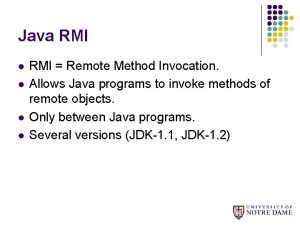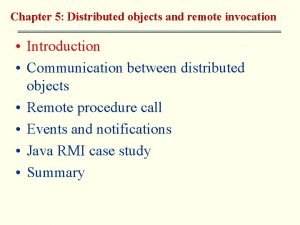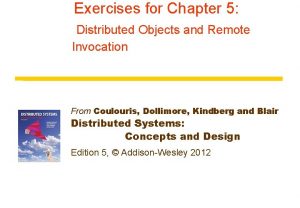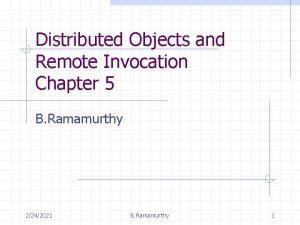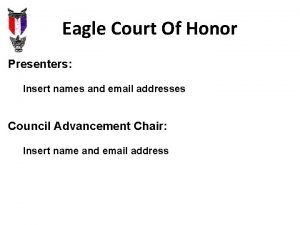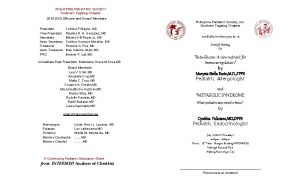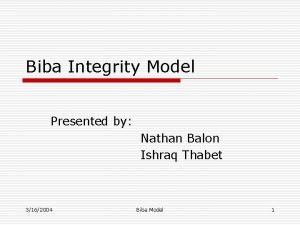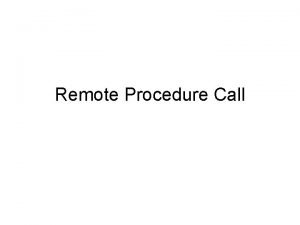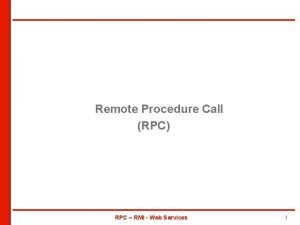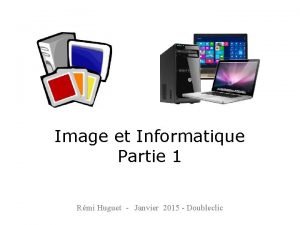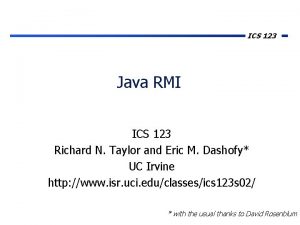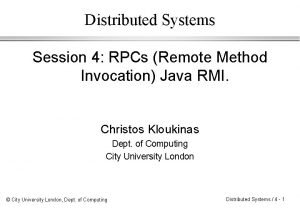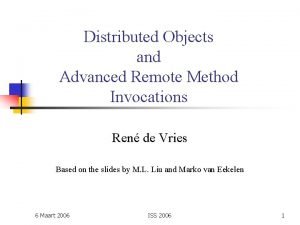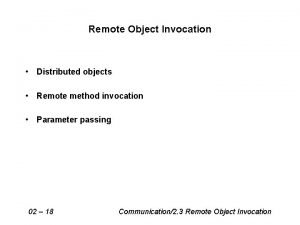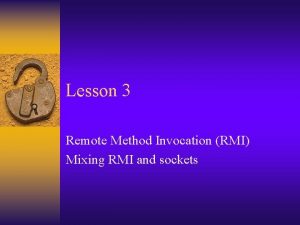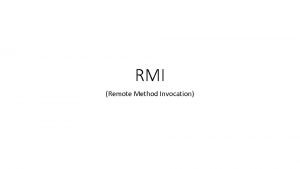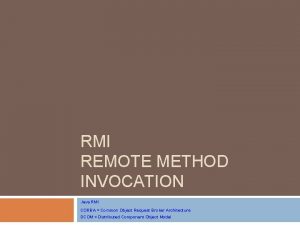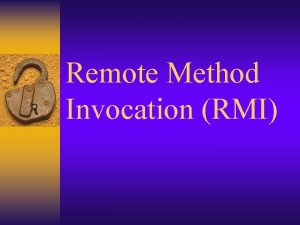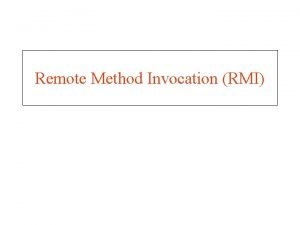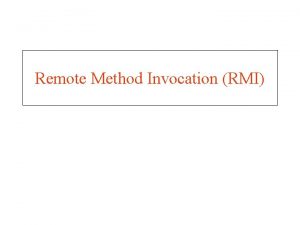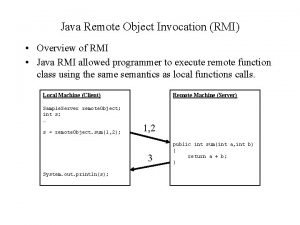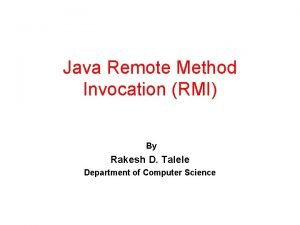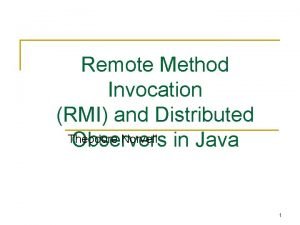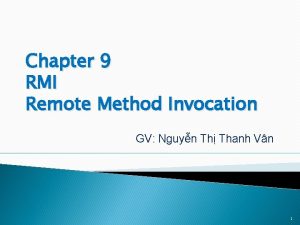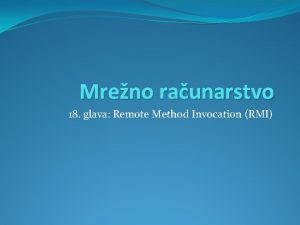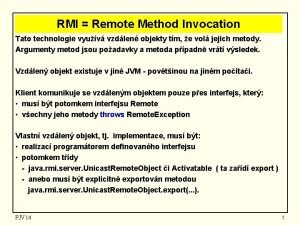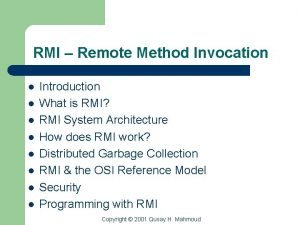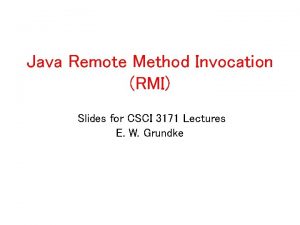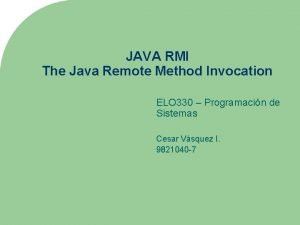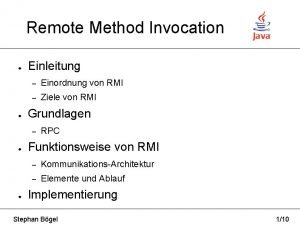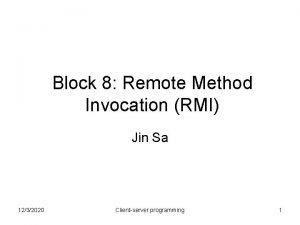RMI What is RMI Remote Method Invocation RMI




















- Slides: 20

RMI

What is RMI? • Remote Method Invocation -RMI allows a Java program to invoke a method that is being executed on a remote machine. – Helps provide access to objects existing on remote virtual machines

What is RMI? cont. • Remote Method Invocation – Remote objects can be treated similarly to local objects – Handles marshalling, transportation, and garbage collection of the remote objects – Became part of the JDK with version 1. 1

What is RMI not? • Not an all-purpose ORB architecture like CORBA and DCOM • Not language independent – Limited only to Java – Interfaces to remote objects are defined using ordinary Java interfaces – Can provide more advanced features like serialization and security

Support for the interface

Interface Support Layers • Stub/skeleton layer – Responsible for managing the remote object interface between the client and server • Remote reference layer – Manages the communication between the client/server and virtual machines

Interface Support Layers, cont. • Transport layer – Actual network/communication layer that is used to send the information between the client and server over the wire – Currently TCP/IP based • Uses serialization and remote procedure call to send information back and forth between remote objects

Interface Support Layers, cont. • Transport layer uses a hierarchy – Initially tries to establish an ordinary socket connection between client and host – If that fails, it tries HTTP – Finally, it will try to use a cgi-script on the server and POST the data

Create the Interface Definition • First thing: define the interface – Interface defines what remote methods and variables are going to be exported from the remote object. – Remote interface must adhere to certain limitations: • must be public • must import the java. rmi. * package • must extend the java. rmi. Remote interface

Create the Interface Definition – Limitations, cont. : • all exported methods must throw an RMI remote exception to manage errors during invocation • all references to remote objects must be references to the interface (not to the remote object itself)

Implement the Interface Definition • Next, implement the remote interface – Limitations: • • • must implement at least one remote interface must import the java. rmi. server. * package must extend java. rmi. server. Unicast. Remote. Object must install a security manager must create at least one instance of a remote object (for instance itself) • must register at least one of the remote objects with the RMI remote object registry

Creating the Stubs/Skeletons • Stubs and skeleton code generated by using the rmic compiler – rmic compiler creates stub and skeleton classes – *_Stub and *_Skel classes are where the references to the remote objects will resolve to in the client's address space – RRL will manage the mapping of these objects to the server's address space

Client • Must import java. rmi package and java. rmi. RMISecurity. Manager • Client must register with a security manager – RMI Security Manager – Loading of classes • Classes loaded from the network cannot be trusted • If no security manager exists, only classes from the local file system will be loaded

Client, cont. • After registering the security manager – create a URL string that is comprised of the server name and remote object name you are requesting • rmi: //my. host. edu/my. Server • “my. Server” is the remote object – enables the client to look up the remote object on the server via the rmiregistry

Client, cont. • Once the remote reference is made – Client can invoke remote methods on the remote object – The remote object is then treated as if it were a local object

Server • Has the same requirements as the client regarding the security manager • Once the server has registered with the security manager, it must create an instance of the remote object it wants to export

Server, cont. • RMIRegistry – Must be running on the server – Objects registered through this – Clients are given access to remote objects through this • Since the server uses the rmiregistry, you must bind (i. e. , alias) an instance of the object with the name that will be used to look up the object

The future of RMI • Now that it is part of JDK 1. 1, it is highly unlikely that it will be removed at a later date. • According to Sun, RMI has not been (and will not be) replaced by Corba and IIOP. • According to Java. Soft, RMI will be extended in the future with the ability to use IIOP as a transport protocol

Sources • http: //www. edm 2. com/0601/rmi 1. html • http: //www. daimi. aau. dk/%7 Ebouvin/otw/r midescription. html • http: //java. sun. com/products/jdk/1. 1/docs/g uide/rmi/spec/rmi-objmodel. doc. html#167

Thank. You
 Create a java rmi calculator application.
Create a java rmi calculator application. Distributed objects and remote invocation
Distributed objects and remote invocation Distributed objects and remote invocation
Distributed objects and remote invocation Distributed objects and remote invocation
Distributed objects and remote invocation Southville invocation
Southville invocation Invocation in paradise lost
Invocation in paradise lost Lions flag salutation in english
Lions flag salutation in english Chiasmus examples
Chiasmus examples Eagle court of honor invocation
Eagle court of honor invocation The odyssey invocation
The odyssey invocation Pediatric in tagalog
Pediatric in tagalog Biba n 438 ddl
Biba n 438 ddl Java remote method protocol
Java remote method protocol What is the purpose of symposium
What is the purpose of symposium Rmi/rpc
Rmi/rpc Rmi risk of malignancy index
Rmi risk of malignancy index Rmi score
Rmi score Rmi medicina
Rmi medicina Java
Java Rmi in distributed system
Rmi in distributed system Rmi callback
Rmi callback
